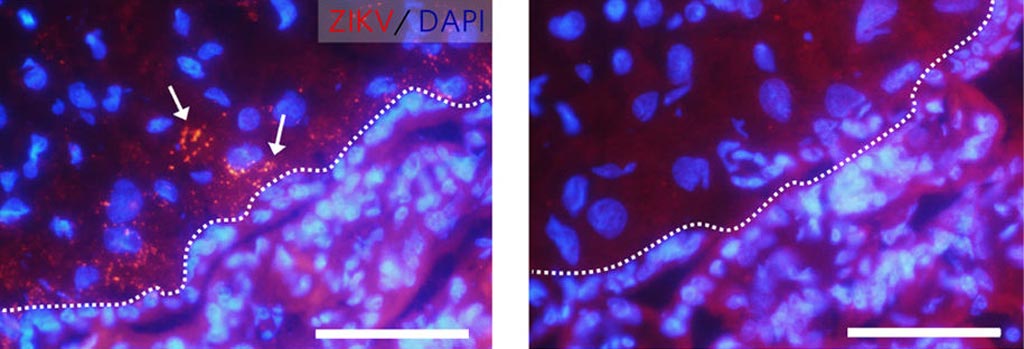Horseradish Complex Increases Sensitivity of Immunochemical Assays
By LabMedica International staff writers
Posted on 01 Aug 2017
A new technique boosts the sensitivity of immunochemical reactions that rely on the enzyme horseradish peroxidase from 100 to 1,000 times.Posted on 01 Aug 2017
This enhanced sensitivity is achieved by combining horseradish peroxidase (HRP), one of the most popular reporter enzymes in biology, with polydopamine (PDA), arguably the most versatile coating material for surface treatment.

Image: Microscopy images taken of Zika-infected primate placenta samples that were stained to detect Zika by immunohistochemistry. The left image shows a sample treated with the EASE protocol, with red/orange colored signals of Zika infection clearly visible (white arrows). The right image shows a sample treated with a standard protocol, and Zika virus - though present - was not detected (Photo courtesy of the University of Washington).
Previously, a simple dip-coating protocol had been demonstrated for spontaneous formation of a thin self-adherent PDA film onto a wide range of surfaces. Recently, however, investigators at the University of Washington (Seattle, USA) found that when dopamine was used in place of the typical HRP substrates, its polymerization rate increased over 300-fold. HRP aggregated dopamine molecules to form the polydopamine polymer chain. Polydopamine, in turn, accumulated on the surfaces of reaction vessels such as microtiter wells, small Petri dishes, or nanoparticles. Once the polydopamine was present, traditional protocols were followed with substantially increased test sensitivity.
PDA has been well known for its outstanding reactivity to the amine, sulfhydryl, and phenol groups in proteins, enabling site-specific deposition in the vicinity of HRP and subsequent sensitive detection based on absorption or fluorescence. Details of this approach, which the investigators called EASE (enzyme-accelerated signal enhancement), were published in the June 5, 2017, online edition of the journal Nature Biomedical Engineering.
"Common bioassays are the real workhorses of laboratory experiments and medical tests," said senior author Dr. Xiaohu Gao, professor of bioengineering at the University of Washington. "By boosting the sensitivity of these tests, we can enable more accurate medical diagnoses earlier in a disease or condition, and enable more certainty and less waste in the research process. EASE has potential to solve real, long-standing problems in research and medical tests."
"Scientists have been trying to improve the accuracy of these common tests for decades, but solutions often involve entirely new protocols or costly pieces of equipment," said Dr. Gao. "Understandably, researchers can be reluctant to invest in unfamiliar protocols or expensive new equipment -- but EASE is a simple addition to tried-and-true assays. It is like a software upgrade, instead of changing your operating system."
Related Links:
University of Washington













